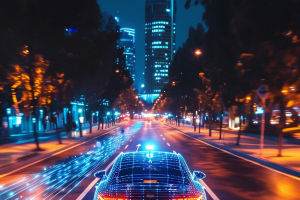We all know that traffic accidents are a leading cause of injury and death worldwide, and many of these accidents could have been prevented.
Imagine a world where artificial intelligence (AI) can foresee potential collisions and help drivers avoid them. Well, we're not far from that reality! AI is rapidly becoming a crucial tool in the prevention of traffic accidents, making roads safer for everyone.
In this article, we'll explore how AI is revolutionizing traffic safety, its key applications, and the promising future it holds in reducing road-related incidents. Let's dive in!
AI-Powered Driver Assistance Systems
One of the most significant contributions of AI to road safety is through Advanced Driver Assistance Systems (ADAS). These systems use AI algorithms, machine learning, and computer vision to monitor a car's surroundings and assist drivers in making safer decisions. Key features of ADAS include:
1. Automatic Emergency Braking (AEB): This system uses AI to detect imminent collisions, such as when a car is about to rear-end another vehicle or pedestrians are in the way. The system automatically applies the brakes if the driver doesn't respond in time, significantly reducing the chances of a crash.
2. Lane Departure Warning (LDW): AI monitors the car's position on the road and warns the driver if the vehicle drifts out of its lane without signaling. It can even take corrective action, steering the vehicle back into the correct lane if necessary.
3. Adaptive Cruise Control (ACC): Using sensors and AI, this system adjusts the car's speed to maintain a safe distance from the vehicle in front, helping prevent rear-end collisions during highway driving.
These technologies leverage real-time data from cameras, radar, and sensors to make split-second decisions that can mean the difference between an accident and a safe driving experience.
Predictive AI: Preventing Accidents Before They Happen
AI is not only reactive but also predictive. Using vast amounts of data, machine learning models can predict potential hazards before they even occur. By analyzing data from millions of previous driving scenarios, AI systems can identify patterns that human drivers may miss.
For instance, AI can analyze factors such as weather conditions, traffic patterns, and driver behavior to predict the likelihood of a collision. It can then send warnings or take actions to prevent accidents.
An example of this is the intelligent intersection management systems being developed in smart cities. AI can monitor traffic flow in real time, detecting potential traffic jams, congestion, or accidents. By adjusting traffic lights, warning drivers, and rerouting vehicles, AI can prevent accidents before they even happen.
AI in Traffic Surveillance: Real-Time Monitoring
In addition to in-car applications, AI is also being used in traffic surveillance to monitor road conditions and prevent accidents. AI-powered cameras and drones can detect hazards such as obstacles, road damage, or even driver distractions in real time. Once a potential danger is detected, the system can send out warnings to nearby vehicles or traffic authorities to prevent incidents.
In cities, traffic monitoring AI can help reduce the number of accidents caused by poor infrastructure, such as potholes or roadwork zones. This technology provides cities with the ability to fix issues faster and more efficiently, directly improving driver safety.
AI and Autonomous Vehicles: A Step Toward Safer Roads
The future of road safety is closely tied to autonomous vehicles (AVs), which rely on AI to drive without human intervention. AI in autonomous vehicles can process vast amounts of data from sensors, cameras, and maps to navigate the road safely, making real-time decisions that reduce the likelihood of accidents.
AI systems in self-driving cars are designed to handle a wide variety of tasks, from detecting pedestrians to recognizing traffic signals and making split-second driving decisions.
Emerging Vehicle-to-Vehicle (V2V) technology is being developed to allow cars to share real-time data with each other to prevent collisions, but it is still in early deployment and not yet universal. As this technology becomes more widespread, we can expect a significant reduction in accidents caused by human error, which accounts for about 94% of all traffic incidents, according to the National Highway Traffic Safety Administration (NHTSA).
AI's Impact on Pedestrian and Cyclist Safety
While AI is often associated with improving the safety of vehicle drivers, its influence also extends to the protection of pedestrians and cyclists. AI-equipped cars can detect pedestrians or cyclists in the vicinity, and through advanced sensors and cameras, they can anticipate and prevent accidents by automatically adjusting the vehicle's speed or direction.
For example, some vehicles equipped with AI technology can detect a person walking across the road, even in low visibility conditions like fog or at night. The AI system can then either warn the driver or initiate automatic braking if necessary.
The Challenges and Future of AI in Accident Prevention
Despite its incredible potential, AI in traffic safety is not without its challenges. One major issue is the reliability of AI systems. While AI is great at analyzing data, it still depends on accurate sensors and perfect environmental conditions. For instance, heavy rain, fog, or snow can sometimes interfere with AI's ability to properly detect obstacles, which could potentially lead to false alarms or system failures.
Moreover, while AI is getting better at simulating human decision-making, it can still struggle with complex, real-world situations that require judgment. Human drivers are able to make decisions based on a wide variety of factors, some of which AI may not yet fully understand.
Despite these challenges, AI in traffic accident prevention is advancing rapidly. As AI algorithms continue to improve and new technologies emerge, the road to safer roads will undoubtedly become clearer. Researchers are also working on improving data-sharing frameworks between vehicles, infrastructure, and traffic management systems to enhance AI's ability to prevent accidents.
Conclusion: A Safer Future Awaits
In conclusion, AI is already playing a critical role in preventing traffic accidents and making our roads safer. From ADAS systems that help drivers avoid accidents to predictive AI that prevents collisions before they happen, the potential for AI to transform road safety is immense.
As technology continues to evolve, we can look forward to an even safer driving experience, with fewer accidents and fatalities. While challenges remain, the future of AI in traffic safety looks incredibly promising, and it's clear that AI will be a key player in the pursuit of zero traffic accidents.
What do you think about AI's role in road safety? Do you feel safer knowing that AI is actively working to prevent accidents? Let us know your thoughts!


